Which one is a nucleophilic substitution reaction among the following ?
RCHO+R'Mgx→R−C∣OHH−R
CH3−CH2−oevrset(CH3)∣CH−CH2Br+NH3→CH3−CH2−CH3∣CH−CH2NH2
CH3CHO+HCN→CH3CH(OH)CN
CH3−CH=CH2+H2OH+−−→CH3−C∣OHH−CH3
The correct Answer is:B
To determine which reaction is a nucleophilic substitution reaction, we will analyze each option provided in the question step by step.
Step 1: Analyze Reaction A
Reaction A: CH3CHO + HCN
- In this reaction, HCN dissociates into H⁺ and CN⁻.
- The H⁺ ion interacts with the oxygen of the carbonyl group (C=O), forming a positively charged intermediate (C=OH).
- The CN⁻ (nucleophile) then attacks the carbon atom of the carbonyl group, leading to the formation of a new bond.
- This reaction results in the addition of the nucleophile (CN⁻) to the carbon atom, converting the C=O double bond into a C-O single bond.
Conclusion for Reaction A: This is a nucleophilic addition reaction, not a substitution.
Step 2: Analyze Reaction B
Reaction B: CH2=CH2 + H2O (in the presence of acid)
- The double bond (C=C) reacts with H⁺ from the acid, forming a carbocation intermediate.
- Water (H2O) acts as a nucleophile and attacks the carbocation, leading to the formation of an alcohol.
- The double bond is converted into a single bond, and a new hydroxyl group is added.
Conclusion for Reaction B: This is also a nucleophilic addition reaction.
Step 3: Analyze Reaction C
Reaction C: RCHO + R'MgX (in acidic conditions)
- The R' group from the Grignard reagent (R'MgX) acts as a nucleophile and attacks the carbonyl carbon of RCHO.
- This forms a new carbon-carbon bond and results in the formation of an alcohol after the addition of acid.
Conclusion for Reaction C: This is again a nucleophilic addition reaction.
Step 4: Analyze Reaction D
Reaction D: CH3CH2CHBr + NH3
- In this reaction, ammonia (NH3) acts as a strong nucleophile.
- The nitrogen in NH3 attacks the carbon atom bonded to bromine (Br), leading to the displacement of Br⁻.
- The product formed is CH3CH2CH(NH2) + HBr, where bromine is replaced by the amine group.
Conclusion for Reaction D: This is a nucleophilic substitution reaction.
Final Answer
The correct option that represents a nucleophilic substitution reaction is D.
---
Reaction A: CH3CHO + HCN
- The H⁺ ion interacts with the oxygen of the carbonyl group (C=O), forming a positively charged intermediate (C=OH).
- The CN⁻ (nucleophile) then attacks the carbon atom of the carbonyl group, leading to the formation of a new bond.
- This reaction results in the addition of the nucleophile (CN⁻) to the carbon atom, converting the C=O double bond into a C-O single bond.
Reaction B: CH2=CH2 + H2O (in the presence of acid)
- Water (H2O) acts as a nucleophile and attacks the carbocation, leading to the formation of an alcohol.
- The double bond is converted into a single bond, and a new hydroxyl group is added.
Reaction C: RCHO + R'MgX (in acidic conditions)
- This forms a new carbon-carbon bond and results in the formation of an alcohol after the addition of acid.
Reaction D: CH3CH2CHBr + NH3
- The nitrogen in NH3 attacks the carbon atom bonded to bromine (Br), leading to the displacement of Br⁻.
- The product formed is CH3CH2CH(NH2) + HBr, where bromine is replaced by the amine group.
The correct option that represents a nucleophilic substitution reaction is D.
Topper's Solved these Questions
- ORGANIC CHEMISTRY : SOME BASIC PRINCIPLES AND TECHNIQUES BOOK - ICSECHAPTER - ORGANIC CHEMISTRY : SOME BASIC PRINCIPLES AND TECHNIQUES EXERCISE - TRUE OR FALSE TYPE QUESTIONS
50 Videos
- ORGANIC CHEMISTRY : SOME BASIC PRINCIPLES AND TECHNIQUES BOOK - ICSECHAPTER - ORGANIC CHEMISTRY : SOME BASIC PRINCIPLES AND TECHNIQUES EXERCISE - FILL IN THE BLANK TYPE QUESTIONS
46 Videos
- ORGANIC CHEMISTRY : SOME BASIC PRINCIPLES AND TECHNIQUES BOOK - ICSECHAPTER - ORGANIC CHEMISTRY : SOME BASIC PRINCIPLES AND TECHNIQUES EXERCISE - ESSAY ( LONG ANSWER ) TYPE QUESTIONS
42 Videos
- HYDROGENBOOK - ICSECHAPTER - HYDROGENEXERCISE - NCERT TEXT-BOOK EXERCISE (With Hints and Solutions)
53 Videos
- REDOX REACTIONS (OXIDATION AND REDUCTION)BOOK - ICSECHAPTER - REDOX REACTIONS (OXIDATION AND REDUCTION)EXERCISE - NCERT TEXT-BOOK. EXERCISES ((With Hints and Solutions)
69 Videos
Similar Questions
Knowledge Check
Vinylic halides are unreactive towards nucleophilic substitution because of the following except :
AC-halogen bond is strongBThe halogen is bonded to sp2 carbonCA double bond character is developed in the carbon-halogen bond by reasonanceDHalide ions are not good leaving groupsConsider the following anions.

When attached to sp -hybridized carbon, their leaving group ability in nucleophilic substitution reaction decreases in the order :AI gt II gt III gt IVBI gt II gtIV gt IIICIV gt I gt II gt IIIDIV gt III gt II gtIWhich of the following reactant will not favour nucleophilic substitution reaction ?
A BPh-BrCCH3CH3∣C∣CH3−CH2−BrDAll the above
BPh-BrCCH3CH3∣C∣CH3−CH2−BrDAll the above
The compound which is least reactive among the following in a nucleophilic substitution reaction is
View SolutionIdentify number of nucleophilic substitution reactions in the given reactions?

View Solution(i) Why are haloalkanes more reactive towards nucleophilic substitution reaction than haloarenes ?
(ii) Which one of the following two substance undergoes SN1 reaction faster and why ?

View SolutionWhich of the following is least reactive in a nucleophilic substitution reaction?
View SolutionExplain why nucleophilic substitution reactions are not very common in phenols ?
View Solution
